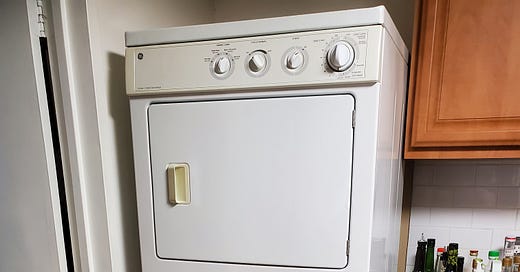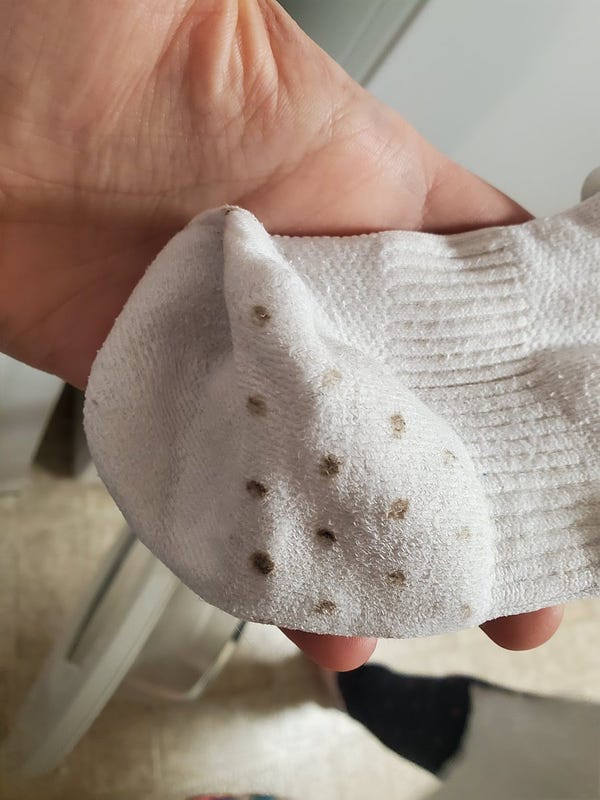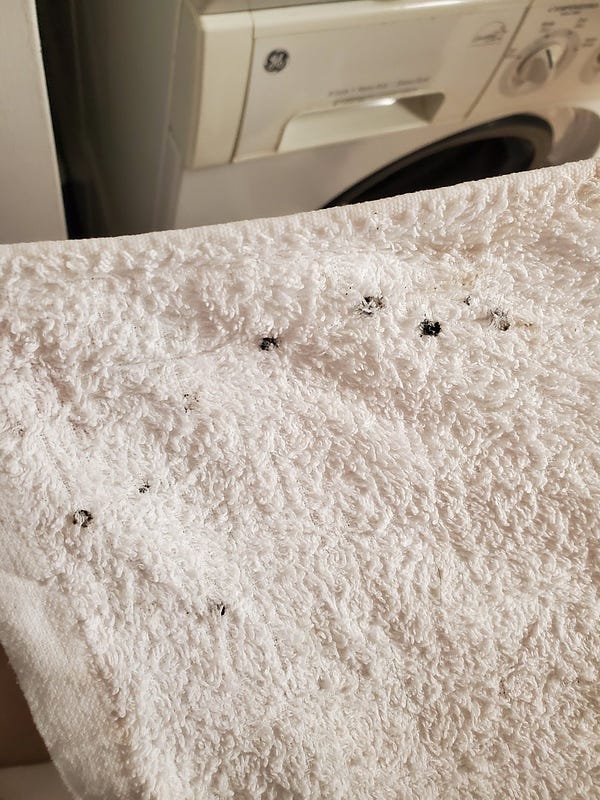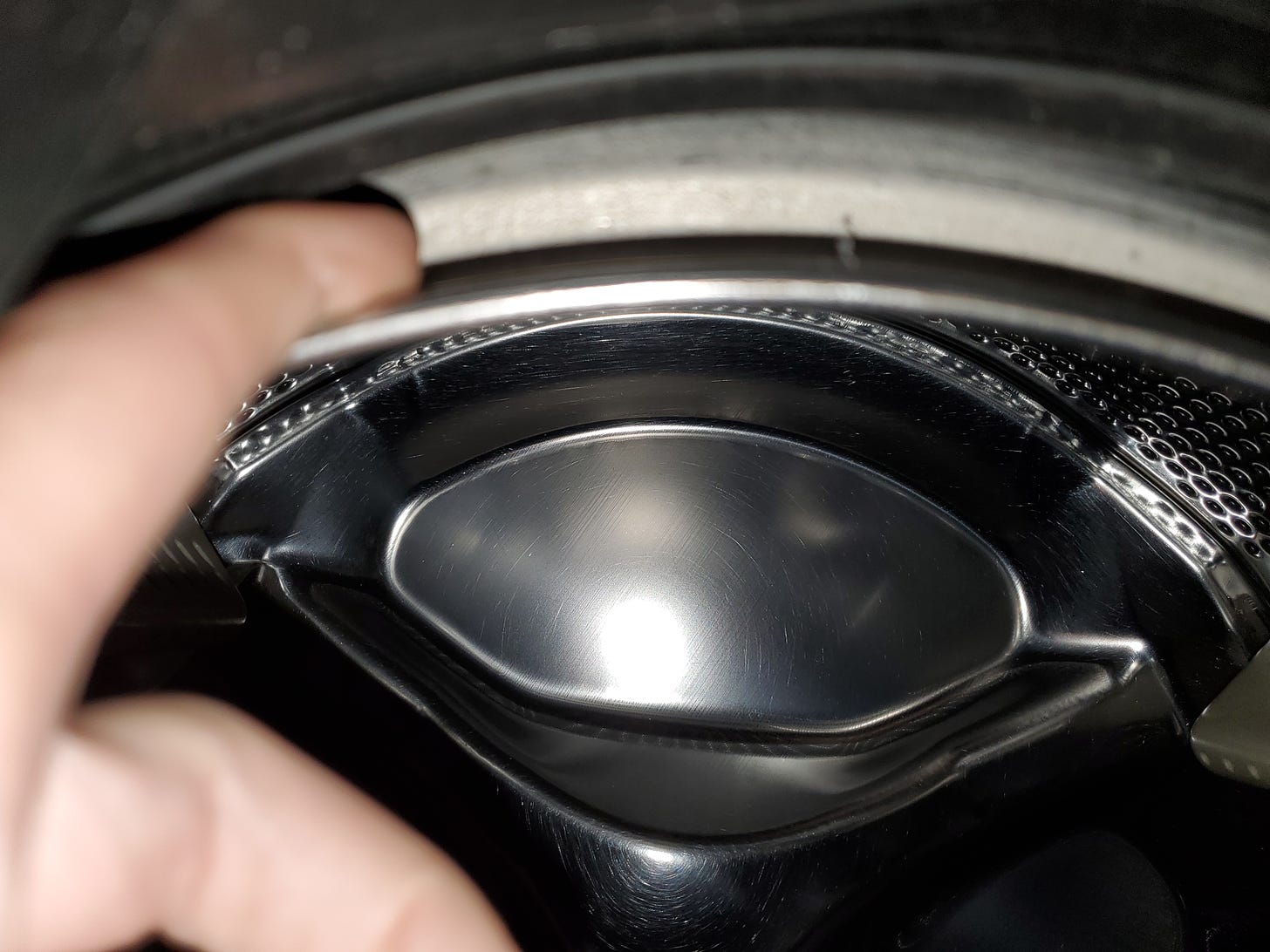This newsletter is “mostly urbanism,” as I like to put it. But from time to time I touch on a handful of other topics: food, retail, old tech, consumer issues. and this piece (and next week’s part 2!) touches on a bunch of those.
Over a year ago, our washing machine in our little condo began to leak from somewhere in the bottom. Large loads caused more leaking; smaller ones often caused none at all. I pulled the front panel off, and I could see a leaking joint under there, but had no idea what to do with it. Since it didn’t leak all the time, we put up with it for awhile, until it began to leak every time it ran.
It’s a separate washer and dryer, GE brand, stacked in this tight space between the dishwasher and the living room wall, where it just clears the doorway. Despite being shallow and a little narrow, the inside capacity is pretty generous. The date stamp is March 2001—neither the washer nor the dryer had had a problem before, so I guess we were lucky. Here it is (this is important).
So, in November of 2021, we finally had someone come look at it. We have a pretty good home warranty—it’s already replaced our air conditioner for about a fifth the actual price—and they sent someone over. He fixed it, but I felt kind of silly, He pulled the front bottom panel off, tightened a screw with an electric screwdriver, and told us we were all good. Just $100, please. I guess I was paying for the knowledge of which screw to tighten.
The repair technician also noted that this 20-year-old pair of machines would probably outlive a modern washer and dryer. He said he got calls all the time for recent models, and told us to hold on to these. I was planning to anyway—I generally dislike buying stuff, and I have seen many times before how older products often have excellent build quality—but I didn’t know new models were that unreliable. (Apparently, LG fridges often fail within a year or two, for example. I think of the old Kenmore from the 1970s in a dorm lounge at my old college, which is probably still chugging away.) I was looking forward to many more years of my slim, spacious GE laundry set.
Well.
Fast forward three months, and this happened:
A week or two before these spots, we’d started seeing splotches on clothes that looked like oil or mud, but they washed out easily enough, so I figured they weren’t oil. I poked around in our washing machine and discovered that the rubber seal was pretty dirty, and that it also had an informally repaired bit of damage—a small hole covered over with some peeling, dirty duct tape. I figured the dirt had built up to a point where it was coming off on the clothes, so I washed down the seal well and replaced the tape.
But then those spots in the photo above appeared on clothing—it sure looked like oil was seeping through the holes in the tub. However, nobody answered the tweet, and I couldn’t find similar pictures online to suggest what might be wrong.
I threw a cleaning capsule in the machine, ran another load a week later, and it came out clean. All good. It did sound a bit loud, but I thought nothing of it. The next load, though—with each spin of the tub inside, at super high speed, it sounded like a gunshot. When it stopped and I looked inside, the tub and drum assembly had come loose inside the machine, and you could wiggle the tub around. There were shreds of some kind of seal inside as well. The space where my fingers are in this picture is not supposed to exist:
Another call to the home warranty company, another $100 service call fee. The technician looked inside, and it took him five seconds to say the machine was junked and should be replaced. Apparently, the entire inside assembly had blown up. Spin basket, front tub, rear tub, tub seal, bellows, shock absorber, springs, even the bearings (probably the source of the oil spots.) He said the parts and labor would exceed not just the value of the old washer, but the cost of a new one. Sort of like replacing the tube in a tube television.
I told him, however, that I would prefer the old one, and he agreed that the new models weren’t very good. I asked him to communicate my preference, and see if the warranty company would cover the repair.
Then I wrote my check, and waited. And the saga wasn’t even close to over.
Related Reading:
A Repair Journey Through Low-Cost Manufacturing
Please consider upgrading to a paid subscription to help support this newsletter. You’ll get a weekend subscribers-only post, plus full access to the archive of over 300 posts and growing—more than one full year! And you’ll help ensure more material like this!









My best advice for appliances is to ask an appliance repair person what they recommend. In my case, going with Bosch for a dishwasher wasn't a great choice; I learned after multiple repairs over 5 years that the heating element in the back wasn't compatible with my 120-year old house with little insulation in the walls (it kept freezing in cold weather). My repair guy recommended Kitchen Aid and I've had no problems ever since.